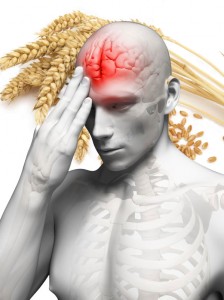By Sayer Ji
Contributing Writer for Wake Up World
With increasing recognition among medical professionals and the lay public alike that the health of gut and brain are intimately connected (i.e. the ‘gut-brain‘ axis), the concept that gluten-containing grains can damage the human brain is beginning to be taken more seriously.
Books like Dr. William Davis’ New York Times best-selling Wheat Belly made great progress in opening up popular consciousness to the subject of gluten’s addictive properties, my own e-book The Dark Side of Wheat explored the role that wheat and grains in general played as an addictive agent, and Dr. David Perlmutter’s new book Grain Brain places significant emphasis on this connection as well.
After all, if wheat is a common cause of intestinal damage (“enteropathy”) both in those with celiac disease and non-celiac gluten sensitivity, it is no wonder that gluten-associated damage to the gut – sometimes called the “enteric brain,” or “second brain,” – could have adverse effects to the central nervous system as well.
Indeed, our research project at GreenMedInfo.com has identified in biomedical literature directly from the National Library of Medicine over 200 adverse health effects linked to gluten-containing grains, with neurotoxicity top on the list of 21 distinct modes of toxicity associated with this grain’s effects.[i] These neurotoxic properties extend from neuropathy and ataxia, to distinct psychiatric conditions such as acute states of mania, and schizophrenia.
A recent study published in the Journal of Neurology, Neurosurgery and Psychiatry titled, “Hyperexcitable brain and refractory coeliac disease: a new syndrome,” has identified a “new syndrome” within the broader array of so-called “gluten related disorders (GRD)” which the authors are calling “Hyperexcitable brain and refractory celiac disease.”
According to the study, “Whilst coeliac disease (gluten sensitive enteropathy) remains one of the best characterised GRD, neurological dysfunction is one of the commonest extraintestinal manifestations with a range of presentations such as cerebellar ataxia, neuropathy, sensory ganglionopathy and encephalopathy (headaches and white matter abnormalities).”
They point out that neurological manifestations of gluten-induced toxicity can occur with or without evidence of intestinal damage (enteropathy). While wheat-induced intestinal damage is far more common than most suppose (read: Research Proves Wheat Can Cause Harm to Everyone’s Intestines), the problem with gluten stretches far beyond the intestinal wall to so-called “out-of-intestine” adverse health effects. And given the fact that many of the peptide sequences within the vast array of proteins that we colloquially refer to as ‘gluten’ — as if it were a singular entity versus the 23,000 plus proteins it is actually comprised of — are pharmacologically psychoactive, it is no wonder that adverse neurological/cognitive consequences follow its ingestion.
The new study describes a case study involving 7 patients (5 male, 2 female) who were identified from a cohort of 540 patients with neurological manifestations of “Gluten related disorders (GRD).” These patients showed signs of “myoclonic tremor,” which is an involuntary muscle twitching, which initially occurred in their face, tongue, one arm or one leg, “but then spread to affect other parts of the body.” So severe was the tremor that 5 of the patients suffered from epileptic seizures, progressing from “Jacksonian seizures,” a type of epilepsy that are initiated with abnormal electrical activity within the primary motor cortex, and may involve a wide range of behaviors from drooling, smacking of the lips, apparently purposeful movements such as turning of the head, etc. Furthermore, all the patients were described as having “limb ataxia and more prominent gait ataxia” – ataxia being a lack of voluntary coordination of muscle movements.
Electrophysiology ‘brain tests’ showed evidence of cortical myoclonus, which is defined as ‘as involuntary brief muscle jerks originating from an abnormal discharge of the cerebral cortex.’ Further clinical, imaging and/or pathological evaluation revealed some evidence of cerebellar involvement, but this was a secondary feature, distinguishing this new condition from gluten ataxia, where cerebellar ataxia is the most disabling feature.
All patients were made to adhere to a strict gluten-free diet, but even after eliminating gluten-related antibodies, there was still evidence of intestinal damage in keeping with so-called ‘refractory’ or treatment resistant celiac disease. The researchers believe that this syndrome, while rare, is the commonest neurological manifestation of refractory celiac disease. They concluded:
The clinical manifestations [of the newly named disorder] extend from focal reflex jerks to epilepsia partialis continua, covering the whole clinical spectrum of cortical myoclonus. This entity is possibly under-diagnosed and difficult to treat.
This study, of course, only addresses the small exposed tip of the massive Gluten-Related Disorder ‘Iceberg’. But it does add renewed focus to the topic of wheat and gluten’s brain-damaging and/or mind-altering properties. Here are some additional studies linking wheat to brain issues:
- A high prevalence of gluten sensitivity is found in sporadic and hereditary cerebellar ataxia. A high prevalence of gluten sensitivity is found in sporadic and hereditary cerebellar ataxia. – Ann Neurol. 2001 Apr;49(4):540-3. PMID:
- Antigliadin antibodies are found at a higher prevalence in Cuban patients with spinocerebellar ataxia type 2. J Neurol Neurosurg Psychiatry. 2008 Mar ;79(3):315-7. Epub 2007 Oct 19.
- Antigliadin antibodies are found at a higher prevalence in Cuban patients with spinocerebellar ataxia type 2. J Neurol Neurosurg Psychiatry. 1999 Jan ;66(1):32-5.
- Epilepsy with cerebral calcifications of unexplained origin may likely be caused by undiagnosed celiac disease. Lancet. 1992 Aug 22;340(8817):439-43.
- Gluten sensitivity is a clinically confirmed problem in multiple sclerosis. Ann N Y Acad Sci. 2009 Sep;1173:343-9. Ann N Y Acad Sci. 2009 Sep;1173:343-9.
- Gluten sensitivity is associated with sporadic cerebellar ataxia in Taiwan. Acta Neurol Taiwan. 2010 Dec;19(4):263-9.
- Headache and CNS white matter abnormalities may be associated with gluten sensitivity. Neurology. 2001 Feb 13 ;56(3):385-8.
- Highly significant increases compared with controls were found in patients with multiple sclerosis for IgA and IgG antibodies against gliadin and gluten and IgA antibodies against casein. Acta Neurol Scand. 2004 Oct;110(4):239-41.
- Individuals with schizophrenia have a novel immune response to gluten. Schizophr Res. 2010 May;118(1-3):248-55. Epub 2009 Sep 11.
- Markers of gluten sensitivity and celiac disease are increased in recent-onset psychosis and multi-episode schizophrenia. Biol Psychiatry. 2010 Jul 1;68(1):100-4. Epub 2010 May 14.
- Neurological symptoms occur in 6-10% of those with celiac disease, with cerebella ataxia being the most frequent symptom. Mov Disord. 2009 Dec 15;24(16):2358-62.
- Persons with schizophrenia have higher than expected titers of antibodies related to celiac disease and gluten sensitivity. Schizophr Bull. 2011 Jan;37(1):94-100. Epub 2009 Jun 3.
- Schizophr Bull. 2011 Jan;37(1):94-100. Epub 2009 Jun 3. Neurology. 2010 Sep 14;75(11):1003-8.
- There is a high prevlance of gluten sensitivity in Japanese patients with adult-onset cerebellar ataxia. Intern Med. 2006;45(3):135-40. Epub 2006 Mar 1.
So, what’s the best way to find out if this research is accurate and relevant for you? My opinion is that the proof is in the gluten-free pudding. Try it out. Eliminate gluten-containing foods for a while, and see how you feel. Observe your memory, your cognition, etc. If it works, it works. If it doesn’t, no harm done.
To learn more, watch Dr. Tom O’ Bryan’s short video on research indicating wheat ingestion can cut off blood flow to the brain.
Article Sources
[i] GreenMedInfo.com, Research > Substances > Index: A-Z > Wheat
Further articles by Sayer Ji:
- Biotech’s Dark Promise: Involuntary Cannibalism for All
- The Cancer-Causing Metal Millions Eat, Wear or Have Injected Into Their Kids
- Turmeric Superior to Chemical Mouthwash In Improving Oral Health
- Biophotons: The Human Body Emits, Communicates with, and is Made from Light
-
The 2013 Measles Outbreak: A Failing Vaccine, Not A Failure To Vaccinate
- 3 Evidence-Based Ways To Reverse Skin Aging Naturally
-
Why Is The Food Industry Poisoning Us With Trillions of Nanoparticles?
- How to Clean Your Arteries With One Simple Fruit
- 13 Evidence-Based Medicinal Properties of Coconut Oil
About the author:
 Sayer Ji is the founder and director of www.GreenMedInfo.com and an advisory board member at the National Health Federation, an international non-profit, consumer education, health-freedom organization.
Sayer Ji is the founder and director of www.GreenMedInfo.com and an advisory board member at the National Health Federation, an international non-profit, consumer education, health-freedom organization.
He co-authored the book Cancer Killers: The Cause Is The Cure, and is currently co-authoring another book with Tania Melkonian entitled EATomology: An Edible Philosophy of Food.
Check out Sayer Ji’s new collaborative project EATomology.com.

If you've ever found value in our articles, we'd greatly appreciate your support by purchasing Mindful Meditation Techniques for Kids - A Practical Guide for Adults to Empower Kids with the Gift of Inner Peace and Resilience for Life.
In the spirit of mindfulness, we encourage you to choose the paperback version. Delve into its pages away from screen glare and notifications, allowing yourself to fully immerse in the transformative practices within. The physical book enriches the learning process and serves as a tangible commitment to mindfulness, easily shared among family and friends.
Over the past few years, Wake Up World has faced significant online censorship, impacting our financial ability to stay online. Instead of soliciting donations, we're exploring win-win solutions with our readers to remain financially viable. Moving into book publishing, we hope to secure ongoing funds to continue our mission. With over 8,500 articles published in the past 13 years, we are committed to keeping our content free and accessible to everyone, without resorting to a paywall.








